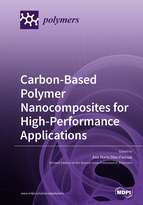Carbon-Based Polymer Nanocomposites for High-Performance Applications
A special issue of Polymers (ISSN 2073-4360). This special issue belongs to the section "Polymer Chemistry".
Deadline for manuscript submissions: closed (10 February 2020) | Viewed by 78162
Special Issue Editor
Interests: nanomaterials; polymers; nanocomposites; inorganic nanoparticles; antibacterial agents; surfactants; interphases
Special Issues, Collections and Topics in MDPI journals
Special Issue Information
Dear Colleagues,
Carbon-based nanomaterials such as carbon nanotubes, graphene and its derivatives, nanodiamond, fullerenes, and other nano-sized carbon allotropes have recently attracted a lot of attention among the scientific community due to their enormous potential for a wide number of applications arising from their large specific surface area, high electrical and thermal conductivity, and good mechanical properties. The combination of carbon nanomaterials with polymers leads to new nanocomposites with improved structural and functional properties due to synergistic effects. In particular, the properties of carbon-based polymer nanocomposites can be easily tuned by carefully controlling the carbon nanomaterial synthesis route and additionally the versatile synergistic interactions amongst the nanomaterials and polymers.
This Special Issue aims to offer a forum for the publication of original research/review articles regarding carbon nanomaterial-reinforced polymeric composites. It includes all types of polymeric matrices (i.e., thermoplastics, epoxies, conducting polymers, bio-polymers, etc.) and covers all branches and aspects of new processing techniques, testing methods, and standards, along with their applications. Novel surface modifications of carbon nanomaterials to develop nanocomposites are welcome, as well as the investigation of the advanced, physicochemical properties of the nanocomposites (as compared with conventional materials). Authors are encouraged to submit their original works stressing the applications of the nanocomposites in a variety of fields, such as in electronics, energy storage, automobiles, aerospace engineering, biomedicine, and so forth.
Potential topics include, but are not limited to, the following:
- Novel techniques for the development of carbon-based polymer nanocomposites;
- The morphological characterization of carbon-based polymer nanocomposites;
- The mechanical and tribological properties of carbon nanomaterial/polymer composites;
- Thermal studies on carbon nanomaterial/polymer composites;
The conducting or optical properties of the nanocomposites; - The surface modification of carbon nanomaterials for improving the interaction with functional groups of polymers and sensing studies;
- Biomedical applications of carbon based-polymer nanocomposites;
- Energy and solar cell applications of carbon nanomaterial/polymer composites.
Prof. Dr. Ana María Díez-Pascual
Guest Editor
Manuscript Submission Information
Manuscripts should be submitted online at www.mdpi.com by registering and logging in to this website. Once you are registered, click here to go to the submission form. Manuscripts can be submitted until the deadline. All submissions that pass pre-check are peer-reviewed. Accepted papers will be published continuously in the journal (as soon as accepted) and will be listed together on the special issue website. Research articles, review articles as well as short communications are invited. For planned papers, a title and short abstract (about 100 words) can be sent to the Editorial Office for announcement on this website.
Submitted manuscripts should not have been published previously, nor be under consideration for publication elsewhere (except conference proceedings papers). All manuscripts are thoroughly refereed through a single-blind peer-review process. A guide for authors and other relevant information for submission of manuscripts is available on the Instructions for Authors page. Polymers is an international peer-reviewed open access semimonthly journal published by MDPI.
Please visit the Instructions for Authors page before submitting a manuscript. The Article Processing Charge (APC) for publication in this open access journal is 2700 CHF (Swiss Francs). Submitted papers should be well formatted and use good English. Authors may use MDPI's English editing service prior to publication or during author revisions.
Keywords
- Nanomaterials
- Carbon nanotubes
- Graphene
- Fullerenes
- Mechanical properties
- Optical properties
- Thermal properties
- Biomedical applications
- Energy applications







